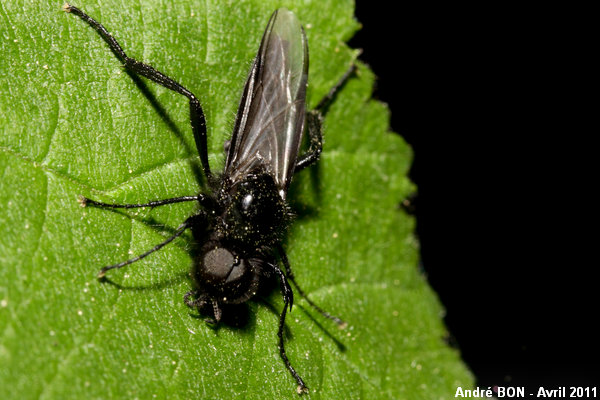



| St. Mark's Fly (Bibio marci (Linnaeus, 1758)) |




|
|
Scientific name: Bibio marci (Linnaeus, 1758) Common name: St. Mark's Fly Other names: Hawthorn Fly French name: Mouche de la Saint-Marc, Bibion Order: Diptera Family: Bibionidae Wingspan : 12-14 mm. Biotope: Meadows, low growing vegetation, woodland edges, clearings, bushes, parks and gardens. Geographic area: Europe, North Africa, Central Asia. Observation period : April-May. |
The common name of St. Mark's Fly comes from the fact that imagos generally emerge around April 25th which is St. Mark's day. Both sexes are hairy and a shiny black colour. The veins on the fore edge of the wings are black and thickened. The tibiae bear a pointing spur. The antennae are short. Males have a large rounded head with two large eyes. Females have a very smaller head with small eyes. The flight is slow with legs hanging down. The female of Bibio hortulanus has a reddish body. Bibio promonis has red femora. Bibio sp. larvae can pullulate in the litter. The head is black and shiny. The body is greyish with conical protrudances which are longer at the rear. |
| [To know more about the St. Mark's Fly] [Next picture] [Top] |

|
I have observed these larvae of Bibio sp. under the litter in the garden. I have classified them as Bibio marci following the emergence of many St. Mark's Flies at next spring. |
| [To know more about the St. Mark's Fly] [Next picture] [Previous picture] [Top] |

|
The black head and the conical protrudances are clearly visible on this picture. |
| [To know more about the St. Mark's Fly] [Next picture] [Previous picture] [Top] |

|
The two large eyes forming almost the whole head indicate one male. On this picture you can clearly see the pointing spur on the fore leg tibia. |
| [To know more about the St. Mark's Fly] [Previous picture] [Top] |

|
St. Mark's Flies are not very vigorous insects and you often observe them landed on vegetation. |